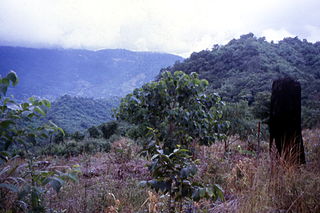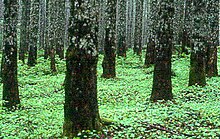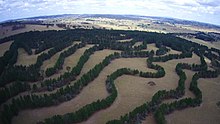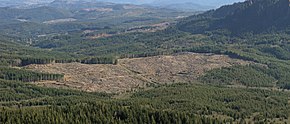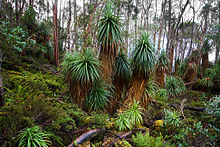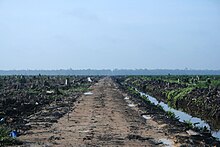Forest management
[20] Forest management plans include recommendations to achieve the landowner's objectives and desired future conditions for the property subject to ecological, financial, logistical (e.g. access to resources), and other constraints.
In Britain, plans featuring "good forestry practice" must always consider the needs of other stakeholders such as nearby communities or rural residents living within or adjacent to woodland areas.
Trees contribute to their environment over long periods of time by improving air quality, climate amelioration, conserving water, preserving soil, and supporting wildlife.
Climax forests are relatively stable ecosystems that have developed the maximum biomass, structural complexity and species diversity that are possible within the limits imposed by climate and soil and without continued disturbance from humans (more explanation here).
[90][91] It contributes to the provision of a wide range of vital ecosystem services and biodiversity conservation, such as wildlife habitats, recreational amenity values, and a variety of non-timber forest products.
The CBD definition is as follows: The ecosystem approach is a strategy for the integrated management of land, water and living resources that promotes conservation and sustainable use in an equitable way.
In Europe, the MCPFE and the Council for the Pan-European Biological and Landscape Diversity Strategy (PEBLDS) jointly recognized sustainable forest management to be consistent with the Ecosystem Approach in 2006.
It typically involves the reduction or removal of barriers to natural regeneration such as soil degradation, competition with weeds, grasses or other vegetation, and protection against disturbances, which can all interfere with growth.
[138] Selecting carefully the forest reproductive material with emphasis on getting a high genetic diversity rather than aiming at producing a uniform stand of trees, is essential for sustainable use of FGR.
[178] Logging companies and forest-worker unions in some countries support the practice for scientific, safety and economic reasons, while detractors consider it a form of deforestation that destroys natural habitats[179] and contributes to climate change.
[28][191][192] This is a voluntary procedure in which an impartial third-party organization evaluates the quality of forest management and output against a set of criteria established by a governmental or commercial certification agency.
There are many potential users of certification, including: forest managers, scientists, policy makers, investors, environmental advocates, business consumers of wood and paper, and individuals.
In its 2009–2010 Forest Products Annual Market Review United Nations Economic Commission for Europe/Food and Agriculture Organization stated: "Over the years, many of the issues that previously divided the (certification) systems have become much less distinct.
[207] While certification is intended as a tool to enhance forest management practices throughout the world, to date most certified forestry operations are located in Europe and North America.
For example, in pre-colonial Africa, community-managed forests served as critical sources of food, medicine, and cultural heritage, governed through traditional norms and local leadership structures.
[217] Similarly, before enclosure or other land privatization efforts, European commons allowed communities to access forests for grazing, fuelwood, and construction materials under shared use.
In regions such as India, colonial forestry policies prioritized timber extraction and commercial gains, often displacing indigenous communities and undermining traditional knowledge.
[222] However, a study by the Overseas Development Institute has shown that the technical, managerial and financial requirements stipulated by community forestry frameworks are often incompatible with local realities and interests.
For example, Mexico’s community forest enterprises (CFEs) demonstrated that decentralized governance could generate substantial economic benefits while maintaining ecological integrity.
[242][243] Proforestation refers specifically to enabling continuous forest growth uninterrupted by active management or timber harvesting, a term coined by scientists William Moomaw, Susan Masino, and Edward Faison.
[247] Rural households in Asia, Africa, and Latin America also depend on forests for about a quarter of their total incomes, with about half of this in the form of food, fodder, energy, building materials and medicine.
Foresters work for the timber industry, government agencies, conservation groups, local authorities, urban parks boards, citizens' associations, and private landowners.
The forestry profession includes a wide diversity of jobs, with educational requirements ranging from college bachelor's degrees to PhDs for highly specialized work.
[252] Similar sustainable formal forestry practices were developed by the Visigoths in the 7th century when, faced with the ever-increasing shortage of wood, they instituted a code concerned with the preservation of oak and pine forests.
Starting with the 16th century, enhanced world maritime trade, a boom in housing construction in Europe, and the success and further Berggeschrey (rushes) of the mining industry increased timber consumption sharply.
His book Sylvicultura oeconomica, oder haußwirthliche Nachricht und Naturmäßige Anweisung zur wilden Baum-Zucht (1713) was the first comprehensive treatise about sustainable yield forestry.
[260] At the time, an alleged tragedy of the commons together with fears of a Holznot, an imminent wood shortage played a watershed role in the controversies about cooperative land use patterns.
Starting from the 1750s modern scientific forestry was developed in France and the German speaking countries in the context of natural history scholarship and state administration inspired by physiocracy and cameralism.
The enactment and evolution of forest laws and binding regulations occurred in most Western nations in the 20th century in response to growing conservation concerns and the increasing technological capacity of logging companies.
[303] In accordance with Article 10 of the Kenyan Constitution, which mandates the incorporation of sustainable development into all laws and decisions regarding public policy, including forest conservation and management.









